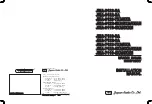
18
PBD-51041066
SITRANS LG270 - Operating Instructions
44295-EN-140321
Keep in mind that a min. distance must be maintained below the refer-
ence plane and possibly also at the end of the probe - measurement
in these areas is not possible (dead band). The length of the cable
can be used all the way to the end only when measuring conductive
products. These blocking distances for different mediums are listed
in chapter "
Technical data
". Keep in mind for the adjustment that the
default setting for the measuring range refers to water.
The process fitting must be sealed if there is gauge or low pressure in
the vessel. Before use, check if the seal material is resistant against
the measured product and the process temperature.
The max. permissible pressure is specified in chapter "
Technical
data
" or on the type label of the sensor.
Standpipes or bypass tubes are normally metal tubes with a diameter
of 30 … 200 mm (1.18 … 7.87 in). In measurement technology, such
a tube corresponds to a coax probe. It does not matter if the stand-
pipe is perforated or slotted for better mixing. Lateral inlets in bypass
tubes also do not influence the measurement.
Measuring probes can be mounted in bypass tubes up to DN 200.
For bypass tubes, select the probe length such that the blocking
distance (dead band) of the probe is above or below the lateral filling
openings. You can thus measure the complete range of the medium in
the bypass tube. When designing the bypass tube, keep the blocking
distance of the probe in mind and select the length above the upper
lateral filling opening accordingly.
Microwaves can penetrate many plastics. For process technical rea-
sons, plastic standpipes are problematic. If durability is no problem,
then we recommend the use of metal standpipes.
When the SITRANS LG270 is used in standpipes or bypass tubes,
contact with the tube wall must be avoided. We recommend for this
purpose a cable probe with centering weight.
With rod probes, a spacer is generally not required. However, if there
is a risk of the rod probe being pressed against the tube wall by in-
flowing medium, you should mount a spacer at the probe end to avoid
contact with the tube wall. In the case of cable probes, the cable can
be strained.
Keep in mind that buildup can form on the spacers. Strong buildup
can influence the measurement.
Pressure
Standpipes or bypass
tubes
















































